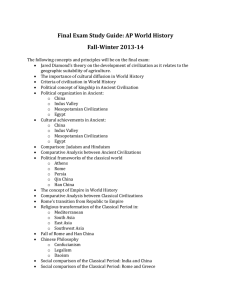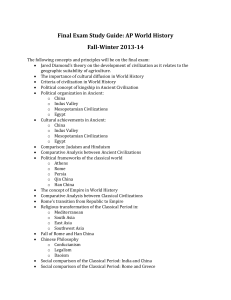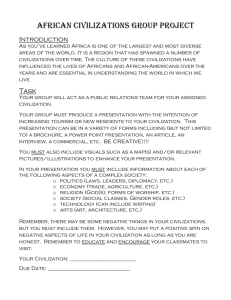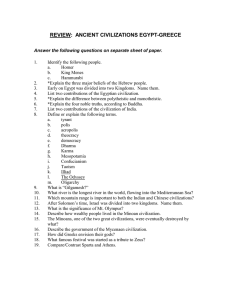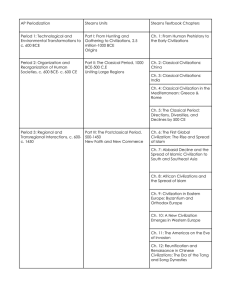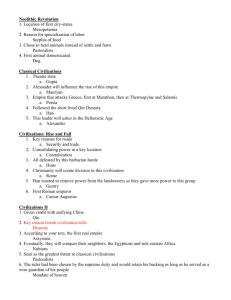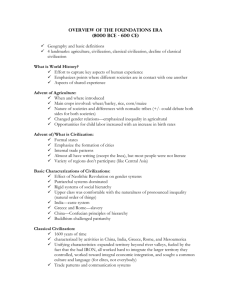AP World History To our Advanced Placement World History students:
advertisement
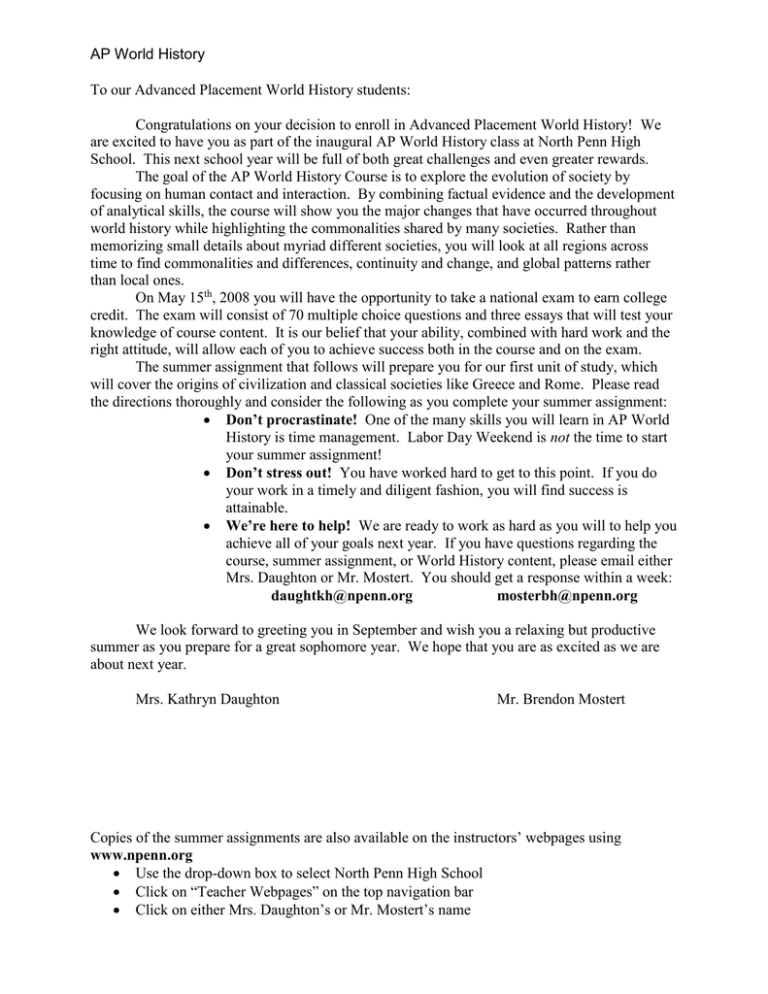
AP World History To our Advanced Placement World History students: Congratulations on your decision to enroll in Advanced Placement World History! We are excited to have you as part of the inaugural AP World History class at North Penn High School. This next school year will be full of both great challenges and even greater rewards. The goal of the AP World History Course is to explore the evolution of society by focusing on human contact and interaction. By combining factual evidence and the development of analytical skills, the course will show you the major changes that have occurred throughout world history while highlighting the commonalities shared by many societies. Rather than memorizing small details about myriad different societies, you will look at all regions across time to find commonalities and differences, continuity and change, and global patterns rather than local ones. On May 15th, 2008 you will have the opportunity to take a national exam to earn college credit. The exam will consist of 70 multiple choice questions and three essays that will test your knowledge of course content. It is our belief that your ability, combined with hard work and the right attitude, will allow each of you to achieve success both in the course and on the exam. The summer assignment that follows will prepare you for our first unit of study, which will cover the origins of civilization and classical societies like Greece and Rome. Please read the directions thoroughly and consider the following as you complete your summer assignment: Don’t procrastinate! One of the many skills you will learn in AP World History is time management. Labor Day Weekend is not the time to start your summer assignment! Don’t stress out! You have worked hard to get to this point. If you do your work in a timely and diligent fashion, you will find success is attainable. We’re here to help! We are ready to work as hard as you will to help you achieve all of your goals next year. If you have questions regarding the course, summer assignment, or World History content, please email either Mrs. Daughton or Mr. Mostert. You should get a response within a week: daughtkh@npenn.org mosterbh@npenn.org We look forward to greeting you in September and wish you a relaxing but productive summer as you prepare for a great sophomore year. We hope that you are as excited as we are about next year. Mrs. Kathryn Daughton Mr. Brendon Mostert Copies of the summer assignments are also available on the instructors’ webpages using www.npenn.org Use the drop-down box to select North Penn High School Click on “Teacher Webpages” on the top navigation bar Click on either Mrs. Daughton’s or Mr. Mostert’s name Summer Reading Assignment AP World History Selected Texts: Guns, Germs and Steel – The Fates of Human Society by Jared Diamond (W.W. Norton & Company 1997). World Civilizations – The Global Experience by Michael Adas, et al (Prentice Hall 5th AP 2007). Your Responsibility: 1. Purchase Guns, Germs, and Steel. Thoroughly read the Prologue - Yali’s Question, pg. 13-32. a. As you read, prepare answers to the following questions. Be prepared to discuss, analyze and be assessed on your knowledge of the topics listed below: i. Connect Jared Diamond’s thesis (pg. 25) to the World Civilizations discussion of the development and spread of agriculture. ii. World Civilizations discusses the emergence of civilization as occurring mainly, though not always, through the formation of agricultural societies. What are the advantages/disadvantages of using the term ‘civilization’ as an organizing principle in history? iii. What is the relationship between environment and the development of agricultural societies? What does Jared Diamond say about this relationship? iv. How do Jared Diamond’s ideas challenge/reinforce popular explanations regarding history’s ‘haves’ and ‘have-nots’? v. What would Jared Diamond argue is the most common source of change—diffusion or independent invention? Based on your answer, how would Diamond explain the development of large regional civilizations during the classical period? 2. Read the packet provided by NPHS from World Civilizations, pg. 2-119. As you read take notes using the guided notes format. a. Please keep in mind that the guided notes provided to you do not and should not substitute a thorough reading of the text. Rather, they provide essential themes and concepts so that you may focus on making connections that will provide a deeper understanding of the content. b. The questions in the details column are there to direct your thinking, but your notes should not be limited to these questions alone. Main Ideas Details PART I: FROM HUNTING AND GATHERING TO CIVILIZATIONS Summary. The earliest known humans lived in east Africa about 2.5 million years ago. These humans lived by hunting and gathering. Gradually, the most advanced human species, Homo sapiens sapiens, migrated from Africa to the Middle East, then into Europe, Asia, Australia, and the Americas. They developed tools out of stones, sticks, and other natural objects. Agriculture began from about 10,000 years ago onward. This in turn encouraged the development of civilization. Early civilizations arose in five different sites, four along the fertile shores of great rivers. The key element in this long phase of human history focuses on adaptation to environments and the search for food supplies. The development of agriculture offered different opportunities for humans, including altered family forms, formal political structures and cites, and monumental buildings. But change took place during this time period slowly. The impact of this change in human civilization can be seen with children who were more supported, nurtured, and disciplined because they were a vital part of the family labor force in agricultural societies. How and where did pre-civilizations first CH 1: From Human Prehistory to the emerge? Early Civilizations Summary. Archeological studies and other scientific methods have provided us with a view of human development that begins millions of years ago. Most of the 2 million-plus years of our existence as a species has been described as the Paleolithic, or Old Stone, Age. This lengthy phase, during which both Homo erectus and then Homo sapiens sapiens made their appearances, ran until about 14,000 years ago. Homo erectus appeared as early as 500,000-750,000 years ago. They stood upright and learned simple tool use, mainly through employing suitably shaped rocks and sticks for hunting and gathering. Several species of Homo erectus developed and spread in Africa and to Asia and Europe, reaching a population of perhaps 1.5 million 100,000 years ago. Homo erectus disappeared about 40,000 years ago. Our immediate ancestors were Homo sapiens sapiens. All current races are descended from this subspecies. Early varieties of Homo sapiens sapiens lived as small bands of huntergatherers. These groups developed language, rituals, and more sophisticated tools. Human Life in the Era of Hunters and Gatherers. Hunting-and-gathering economies dominated human history until 9000 B.C.E. These economies helped propel migration over most of the lands of the Earth. Main Ideas Human Life Before Agriculture. As human societies spread geographically over the Earth, the hunter-gatherer economy benefited with improved tool use. Details Describe human migration patterns across the globe. Late Paleolithic Developments. A variety of human types developed in the Paleolithic time period but these were killed off or displaced by competitors over time. Homo sapiens sapiens originated about 240,000 years ago. Humans today are descendants of this group. Life became easier for these early human ancestors as stone tool use improved. Speech developed with Homo erectus 100,000 years ago. By the late Paleolithic period, people had developed rituals and religion to lessen fear about death and nature. All during this time humans spread from east Africa into Asia and Europe and finally North America. Human development accelerated after the last ice age. In a span of several thousand years from 12,000 to 8,000 B.C.E., humans dramatically improved the ability to fashion stone tools and other implements, including weapons. These Mesolithic people domesticated animals for an improved food supply. With the increased food supply was an increased population, and with that, conflict. The Neolithic Revolution. The Neolithic revolution is the term given to the development of agricultural societies. This revolution in economic, political, and social organization began in the Middle East as early as 10,000 B.C.E. and gradually spread to other centers, including parts of India, north Africa, and Europe. With the rise of agricultural forms of economic production, humans were able to remain settled more permanently in one spot and increase their levels of specialization regarding particular economic, political, and religious functions. Additionally, the emergence of agriculturally based societies caused a massive increase in the sheer number of people in the world. However, most evidence suggests that hunting-and-gathering peoples resisted agriculture as long as they could. By about 3000 B.C.E., metalworking had become common in the Middle East. Like agriculture, knowledge of metals gradually fanned out to other parts of Asia and to Africa and Europe. Metalworking was extremely useful to agricultural and herding societies. Agricultural peoples had the resources to free up a small number of metal tool makers who specialized in this activity and exchanged their product with farmers for food. Civilization. The word “civilization” comes from the Latin term for “city.” Formal states, writing, cities, and monuments all characterize civilizations. Civilizations also exhibit elaborate trading patterns and extensive political territories. While many of the ingredients of civilization had existed by 6000 B.C.E., the origins of civilization, strictly speaking, date to only about 3500 B.C.E. The first civilizations were the river valley civilizations, so-called because they all developed alongside major rivers to secure an adequate water supply for agricultural production. How did sedentary agriculture lead to societal changes? What are the characteristics of a ‘civilization’ and where did they arise? Main Ideas The earliest river valley civilizations began in the Middle East and flourished for many centuries. They created a basic set of tools, intellectual concepts such as writing and mathematics, and political forms that would persist and spread to other parts of Europe, Asia, and Africa. Most of the river valley civilizations were in decline by 1000 B.C.E. Tigris-Euphrates Civilization. This civilization originated in the valley of the Tigris and Euphrates rivers in a part of the Middle East called Mesopotamia. It was one of the few cases of a civilization that started from scratch—with no examples from any place available for imitation. This civilization progressed mostly due to the accomplishments of the Sumerians, the most influential people in the TigrisEuphrates region. By about 3500 B.C.E, the Sumerians had developed the first known human writing, cuneiform. They also were characterized by the development of astronomical sciences, intense religious beliefs, and tightly organized citystates. The Sumerians improved the region’s agricultural prosperity by learning about fertilizers and using silver to conduct commercial exchange. Their ideas about divine forces in natural objects were common among early agricultural peoples; a religion of this sort, which sees many gods in aspects of nature, is known as polytheism. Sumerian political structures stressed tightly organized city-states, ruled by a king who claimed divine authority. Here was a key early example of how a civilization and political structures combined. The government helped regulate religion and enforce its duties; it also provided a system of courts for justice. Kings were originally war leaders, and the function of defense and war, including leadership of a trained army, remained vital. The Sumerians eventually succumbed to the Akkadians, who continued much of the Sumerian culture in the TigrisEuphrates region, and the Babylonians, who developed Hammurabi’s code. It laid down the procedure for law courts and regulated property rights and duties of family members, setting harsh punishments for crimes. This focus on standardizing a legal system was one of the features of early river valley civilizations. Egyptian Civilization. Egyptian civilization emerged in northern Africa along the Nile River by about 3000 B.C.E. It benefited from trade and influences from Mesopotamia, but it also produced its own distinct social structures and cultural expressions. Unlike Mesopotamian civilization, Egyptian civilization featured very durable and centralized institutions. Mathematical achievements and impressive architectural structures also characterized Egyptian civilization. From 2700 B.C.E. onward, the Egyptian pharaohs directed the building of the pyramids, which were to function as their tombs. However, the building of these massive architectural monuments could only be accomplished with the use of an abundance of slave labor. Details How did geography influence the rise of civilizations? Describe the political, social, economic and religious institutions that developed in the first civilizations. Main Ideas Indian and Chinese River Valley Civilizations. A prosperous urban civilization emerged along the Indus River by 2500 B.C.E., supporting several large cities, such as Harappa. Indus River peoples had trading contacts with Mesopotamia, but they developed a distinctive alphabet and artistic forms. Invasions by Indo-Europeans resulted in such complete destruction of this culture that little is known today about its subsequent influence on India. Civilization along the Huanghe (Yellow) River in China developed in considerable isolation, though some overland trading contact developed with India and the Middle East. In addition to the existence of an organized state that carefully regulated irrigation in the flood-prone river valley, the Chinese had produced advanced technology and elaborate intellectual life by about 2000 B.C.E. There was also less of a break between Chinese river valley society and the later civilizations in China than in any other region. The Shang ruled over the Huanghe River valley by about 1500 B.C.E. These rulers are noted for managing the construction of impressive tombs and palaces. Details Describe the social hierarchies, gender relationships and social inequalities of the first civilizations. Can any comparisons be made? The Heritage of the River Valley Civilizations. Basic achievements like the wheel, alphabets, mathematics, and divisions of time are vital legacies of the early civilizations. Mesopotamian art and Egyptian architecture influenced the Greeks, and subsequently the Romans, who both passed on much of their heritage to Muslim and European civilization. The Phoenicians devised a simplified alphabet that greatly influenced the Greek and Latin writing systems. The most influential of the smaller Middle Eastern groups were the Jews, who gave the world the first clearly developed monotheistic religion. In Depth: The Idea of Civilization in World Historical Perspective. The belief that there are fundamental differences between the “civilized” and the “barbarians” is an old and widespread one, used by the Chinese, American Indians, ancient Greeks, and modern western Europeans, to name just a few. The latter attempted to define a series of stages in human development that ranged from utterly primitive to “advanced,” with the advanced culture belonging to the western Europeans. By the 19th century, racial qualities were quantified as qualifiers for position along the hierarchy of “civilization.” In the 20th century much of that intellectual baggage was eventually discarded. At present, the most accepted way to approach a definition of civilization is to see it as one of several ways humans identify social organization. The First Civilizations. The first civilizations established a pattern of division among the world’s peoples. After Homo sapiens sapiens spread to almost every corner of the world and then had relatively little contact with each other, separate languages and cultures developed. But by 1000 B.C.E., the Phoenicians traded with Britain and Chinese silk was sold in Egypt. How does civilized culture survive the rise and fall of regional states? Main Ideas Overall, four distinct centers of civilization developed: the Middle East, India, China, and Egypt (five if the nascent Olmec civilization is included). Each had important commonalities, including trade, writing, and cities, yet each was in many ways different from the others. Thus, the duality of common experience and diversity has been part of the human experience for a very long time. Details Describe the characteristics and chronology of the classical era. Global Connections: The Early Civilizations and the World. The scope and legacy of the first civilizations are unique to geography and other factors. Mesopotamia was flat with few natural barriers to recurrent invasions. Thus the Middle East had an active role as an agent for wider connections with other cultures. Egypt, though not isolated, was more self-contained with the Libyan desert, Nile River, and Red Sea serving as barriers. Therefore, Egypt played less of a role as intermediary among different regions. China also had less far-reaching contacts than Mesopotamia. But it did make major connections with Japan, Korea, and Vietnam. Harappan society did trade widely with Mesopotamia; but its rapid decline limited its impact on surrounding cultures. PART II: CLASSICAL PERIOD Summary. The major development during the classical period was the formation of large regional civilizations in China, India, the Mediterranean, and the Middle East. These areas had by far the largest concentration of population. Furthermore, the influence these civilizations extended into surrounding regions outside their direct control. Much of the development of each civilization was separate and the establishment of distinctive cultural and institutional patterns was a key legacy of this period. One of the triggers for the clear transition into the classical period was the introduction of iron tools and weapons. With this development each classical civilization developed its own social structure, religion, political system, system of science, and style of art. While the introduction of iron in the classical period, the period itself did not witness sweeping technological developments. Patriarchal culture prevailed with a new emphasis on the respect for the achievement of old age. CH 2: Classical Civilization – China Patterns in Classical China. Three dynastic cycles— the Zhou, the Qin, and the Han—covered many centuries of classical China. The dynastic patterns begun in classical Chinese history lasted until the early part of the 20th century. A family of kings, called a “dynasty,” began ruling China with great vigor, developing solid political institutions and encouraging active economies. Describe the changed geographic locations of classical civilizations. What factors encourage or limit contacts between classical cultures? Main Ideas Each dynasty over time grew weaker, tax revenues declined, and social divisions occurred as the population outstripped available resources. In addition, internal rebellions and sometimes invasions from the outside contributed to each dynasty’s decline. As the ruling dynasty began to falter, usually another one arose from the family of a successful general, invader, or peasant, and the pattern started anew. The Zhou dynasty (1029-258 B.C.E.) expanded the territorial boundaries of China by seizing the Yangzi River valley. The territory from the Yangzi to the Huanghe is often called the “Middle Kingdom,” blessed with rich cropland. They promoted Mandarin as the standard language. The Zhou did not establish a strong central government but ruled instead through alliances with regional princes and noble families. This led to vulnerabilities that plagued the Zhou: The regional princes solidified their power and disregarded the central government. When the Zhou began to fail, philosophers sought to explain the political confusion. One of these, Confucius, became one of the most important thinkers in Chinese history. His orderly social and political philosophy became an important doctrine of the Qin and Han dynasties. The next dynasty, the Qin (221-202 B.C.E.), was begun by the brutal but effective emperor Shi Huangdi. He consolidated his power, built the Great Wall, conducted a census, standardized weights and measures, and extended the borders of his realm to Hong Kong and northern Vietnam. Upon his death, massive revolts broke out and by 202 B.C.E., the Han dynasty (202 B.C.E.-220 C.E.) was established. The Han rulers lessened the brutality of the Qin but maintained its centralized rule. Early Han leaders, like Wu Ti, expanded Chinese territory and set up formal training, based on Confucian philosophy, for bureaucrats. During a long decline, the Han faced invasions and eventually fell to outside forces, especially the Huns. By the 6th century C.E., the Han too collapsed, but not before they had established distinctive political and cultural values that lasted into the 20th century. Political Institutions. Throughout the Qin and Han periods, the Chinese state bureaucracy expanded its powers significantly. By the end of the Han dynasty, China had roughly 130,000 bureaucrats all trained by the government to carry out the emperor’s policies. Tax collections and annual mandatory labor services ensured the central government held some power over almost every person in the Middle Kingdom, something no other large government accomplished until the twentieth century. Religion and Culture. Like many civilizations, China did not produce a unitary belief system. Confucianism and Daoism were two of the major systems that competed for the loyalties of various Chinese communities during the years of the classical period. Details How did the Chinese state centralize power and impose unity on a vast region or people? What are the ethical and moral teachings of classical China? How do various philosophical systems unify diverse people? Main Ideas Details How did classical Chinese belief systems Kung Fuzi (Confucius) lived from roughly 551 to 478 B.C.E. He shape social structures and gender was not a religious leader but rather saw himself as a defender relationships? of Chinese tradition and espoused a secular system of ethics. Personal virtue, he believed, would lead to solid political institutions. Both rulers and the ruled should act with respect, humility, and self-control. Classical China also produced a more religious philosophy called Daoism, which embraced harmony in nature. According to this movement, politics, learning, and the general conditions in this world were of little importance. Over time, individuals embraced aspects of both philosophies, and also Buddhism. Chinese art then was largely decorative, stressing detail and craftsmanship. Artistic styles often reflected the geometric qualities of the symbols of Chinese writing. The practical application of science superseded learning for learning’s sake. Chinese astronomers developed accurate calendars. Scholars studied the mathematics of music. This practical focus contrasted with the more abstract approach to science applied by the Greeks. Economy and Society. As in many societies, there were large gaps between China’s upper class (about 2 percent of the population) and the peasant farmers. Officially there were three main social groups in classical China. The land-owning aristocracy and the bureaucrats formed the top group. Far below them were the laboring peasants and urban artisans. At the bottom of society were the “mean people,” those who performed unskilled labor. Trade became increasingly important, particularly in the Han period. Technology is where the classical Chinese clearly excelled. Many developments of this era were centuries ahead of the rest of the world. Tightknit family structures were similar to those in other civilizations, except that parents wielded much higher levels of authority over their children. Women were subordinate to men but had clearly defined roles in the family and in larger society. In Depth: Women in Patriarchal Societies. Agricultural societies were usually patriarchal, and as they developed the status of women generally deteriorated. Marriages were arranged for women by their parents, and husbands had authority over their wives and children. Later, law codes ensured basic protections but also featured limits to and inferiority of women. There were, of course, exceptions. The Egyptians had powerful queens, and Jewish law traced lineage through mothers. Patriarchy responded to economic and legal conditions in agricultural civilizations and often deepened over time. In many societies, women held power through religious functions and had authority over daughtersin-law and unmarried daughters. How Chinese Civilization Fits Together. China’s politics and culture were, to them, two sides of the same coin, especially after the Confucian bureaucracy developed, emphasizing order and stability. Classical Chinese technology, religion, philosophy, and political structure evolved with little outside contact. What class came to dominate the Chinese government and how was it created? Describe the influence of merchants and the importance of trade and commerce to China. Main Ideas Details Political stability aided economic growth, and the government took a direct role in agricultural and economic growth. Science focused on practical applications of technology that fostered economic development. Unsurprisingly, the Chinese saw their political and social lives as a whole. There was divergence, however, such as in the differing philosophies of Confucianism, Daoism, and eventually Buddhism. Despite these and other divisions, the synthesis of Chinese life accounts for the durability of Chinese values and for its general invulnerability to outside influence. Classical India was just as vital a civilization but didn’t weave its institutions into society as fully, and produced a more disparate outcome. Global Connections: Classical China and the World. Chinese civilization was the longest lasting in world history and one of the most creative and influential. They created the best-run bureaucracy and a whole range of technologies, and they were the source of the world’s largest trade network, the Silk Road. Silk Road networks provided the framework for later global trading patterns. CH 3: Classical Civilization – India The Framework for Indian History: Geography and a Formative Period. Important reasons for India’s distinctive path lie in geography and early historical experience. India’s topography shaped a number of vital features of its civilization. The vast Indian subcontinent is partially separated from the rest of Asia (and particularly from east Asia) by northern mountain ranges. Mountain passes linked India to civilizations in the Middle East. Though it was not as isolated as China, the subcontinent was nevertheless set apart within Asia. The most important agricultural regions are along the two great rivers, the Ganges and the Indus. During its formative period, called the Vedic and Epic ages, the Aryans (Indo-Europeans), originally from central Asia, impressed their own stamp on Indian culture. During these ages, the caste system, Sanskrit, and various belief systems were introduced. Patterns in Classical India. By 600 B.C.E., India had passed through its formative stage. Indian development during its classical era did not take on the structure of rising and falling dynasties, as in China. Patterns in Indian history were irregular and often consisted of invasions through the subcontinent’s northwestern mountain passes. As a result, classical India alternated between widespread empires and a network of smaller kingdoms. Even during the rule of the smaller kingdoms, both economic and cultural life advanced. The Maurya and Gupta dynasties were the most successful in India, run entirely by Indians and not by outside rulers. The greatest of the Mauryan emperors was Ashoka (269-232 B.C.E.). The Guptas did not produce as dynamic a leader as Ashoka, but they did provide classical India with its greatest period of stability. How did geography/environment influence Indian civilization? Describe Aryan society and their social and religious institutions. Main Ideas Political Institutions. Classical India did not develop the solid political and cultural institutions the Chinese experienced, nor the high level of political interest of Greece and Rome. Its greatest features, still observable today, were political diversity and regionalism. The Guptas, for example, did not require a single language for all of their subjects. The development of a rigid caste system lies at the heart of this characteristic. In its own way, the caste system promoted tolerance, allowing widely different social classes to live next to each other, separated by social strictures. Loyalty to caste superseded loyalty to any overall ruler. Religion, particularly Hinduism, was the only uniting influence in Indian culture. Religion and Culture. Two major religions, Hinduism and Buddhism, marked classical India. Hinduism, the religion of India’s majority, is unique among world religions in that no central figure is credited for developing it. Hinduism encouraged both worldly and mystical pursuits and was highly adaptable to varying groups. Buddhism was founded on the teachings of an Indian prince, Gautama, later called Buddha, or “enlightened one.” Buddha accepted many Hindu beliefs but rejected its priests and the caste system it supported. Buddhism spread through missionaries into Sri Lanka, China, Korea, and Japan. Classical India also produced important work in science and mathematics. The Gupta-supported university at Nalanda taught religion, medicine, and architecture, as well as other disciplines. Indian scientists, borrowing ideas from Greek learning provided by Alexander the Great, made important discoveries. Still more important were the mathematical advancements, including the concept of zero, “Arabic” numerals, and the decimal system. Indian artists created shrines to Buddha called stupas and painted in lively colors. Economy and Society. India developed extensive trade both within the subcontinent and on the ocean to its south. The caste system described many key features of Indian society and its economy. The rights of women became increasingly limited as Indian civilization developed; however, male dominance over women was usually greater in theory than in practice. The economy in this era was extremely vigorous, especially in trade, surpassing that in China and the Mediterranean world. Merchants traded from the Roman Empire to Indonesia to China. In Depth: Inequality as the Social Norm. The Indian caste system, like the Egyptian division between noble and commoner and the Greco-Roman division between free and slave, rests on the assumption that humans are inherently unequal. Details Describe the Maurya and Gupta political and economic institutions. Characterize the relationship between Hinduism and Buddhism in India. How do classical Indian belief systems shape social structures and gender relationships? Main Ideas All classical social systems (with the partial exception of Athens’ democracy) played down the importance of the individual and emphasized obligations to family, group, and government. This runs counter to modern Western notions about equality. Classical China and Greece probably came closest to modern views about individuality, but in both civilizations, it was largely expected that rulers should come from society’s elites. In nearly all societies throughout most of human history, few challenged the “natural order” of social hierarchy and fewer still proposed alternatives. Details What factors encourage/limit contacts between the classical civilizations? Indian Influence. Because of its extensive trading network, Indian cultural influence spread widely, especially in southeast Asia. Buddhism was a leading cultural export. Indian merchants often married into royal families in other areas. Political dominance of outside peoples was not a characteristic of Indian governments. China and India. China and India offer important contrasts in politics and society, yet they resembled each other in that both built stable structures over large areas and used culture to justify social inequality. The restraint of Chinese art contrasted with the more dynamic style of India. The latter developed a primary religion, Hinduism, while the former opted for separate religious and philosophical systems. Chinese technological advancements stressed practicality, while Indians ventured into mathematics for its own sake. Indian merchants played a greater societal role than their Chinese counterparts. Both, however, relied on large peasant classes in agrarian settings; both accepted political power based on land ownership. Compare and contrast classical China and India. Global Connections: India and the Wider World. No classical civilization was more open to outside influences than India. None was more central to cross-cultural exchanges in the common era. Important innovations in mathematics and science came from classical India. Buddhism is one of the few truly world religions. Indian influence was especially important in southeast Asia. Placed between the great empires and trading networks of the Mediterranean and of China, India was ideally situated for its culture to influence both East and West. CH 4: Classical Civilization in the Mediterranean – Greece and Rome Summary. The civilizations of Greece and Rome rivaled those of India and China in cultural richness and their effect on world history. Their institutions and values reverberated in the later histories of the Middle East and Europe and Europe’s colonies around the world. The study of classical Mediterranean civilization is complicated because it includes Greek and then Roman political, social, and economic institutions, which were sometimes shared but often unique. How did geography influence Greek and Roman civilization? Main Ideas The Persian Tradition. Greeks and Romans had contacts with and were influenced to some degree by the large Persian Empire and its descendants. The Persians absorbed many of the attributes of earlier Mesopotamian societies. Zoroastrianism, an early monotheistic religion, came from within the empire. After being toppled by the Greek leader Alexander the Great, another empire arose—the Sassanid— during Rome’s imperial era. Details What principles motivated Greco-Roman society and culture? Patterns of Greek and Roman History. The rise of the dynamic city-states of classical Greece began around 800 B.C.E., reaching a high point in the 5th century B.C.E. with the leadership of the Athenian Pericles. The next major era came under the expansionist Alexander, who briefly united Greece and the Persian Empire. The legacy of the combination of the two civilizations was called Hellenism. Rome’s development as a republic began as Hellenism waned. As Rome gained more territory by challenging regional powers and lesser developed cultures, it grew into an empire. Greece. The Greeks were an Indo-European people who took over the Greek peninsula by 1700 B.C.E. From 800 to 600 B.C.E. Greek civilization rose to prominence rapidly with the creation of strong city-states. Each city-state had its own government, typically either a tyranny of one ruler or an aristocratic council. Sparta and Athens came to be the two leading city-states. Sparta represented a strong military aristocracy, while Athens was a more diverse commercial state that was proud of its artistic and intellectual leadership. During the 5th century Pericles dominated Athenian politics, creating a democratic political structure where each citizen could participate in government. Political decline soon set in for the city-states as Athens and Sparta vied for control of Greece during the Peloponnesian Wars. Afterwards the city-states were conquered by Philip II of Macedon and then his son Alexander the Great, who extended the Macedonian Empire throughout the Middle East and Egypt. Although this empire did not last long beyond Alexander’s death, the Hellenistic period, as it is called, saw the merging of Greek art and culture with other Middle Eastern forms and had influence well beyond the end of the empire. Rome. The Roman state began as a local monarchy in central Italy around 800 B.C.E. Roman aristocrats succeeded in driving out the monarchy in 509 B.C.E. The new Roman republic gradually extended its influence over the rest of the Italian peninsula. Roman influence widened during the three Punic Wars, from 264 to 146 B.C.E., during which Rome fought and defeated the armies of the Phoenician city of Carthage. The politics of the Roman republic grew unstable as victorious generals sought even greater power while the poor of the city rebelled. How did warfare and conquest shape classical Mediterranean cultures? Main Ideas In 45 B.C.E. Julius Caesar ended the traditional institutions of the Roman state. Caesar’s grandnephew, Augustus Caesar, seized power in 27 B.C.E. and established the basic structures of the Roman Empire. For 200 years the empire maintained great vigor, bringing peace and prosperity to the entire Mediterranean world. Then the empire suffered a slow fall that lasted about 250 years until invading peoples from the north finally overturned the government in Rome in 476 C.E. Greek and Roman Political Institutions. Greece and Rome featured an important variety of political forms. Both tended to emphasize aristocratic rule but there were significant examples of democratic elements as well. Politics was very important in the classical Mediterranean civilizations and offered similarities to Confucian values, yet the variety of political forms reminds the historian of India. There was no single Greek political style, but democracy is the most famous. Classical Mediterranean political theory involved ethics, duties of citizens, and skills, such as oratory. Governments supported an official religion, but tolerance of other faiths was the norm. The exception, Christianity under the Roman Empire, occurred because Christians refused to place state first in their devotion. The greatest political legacies of the Mediterranean cultures were an intense loyalty to the state, a preference for aristocratic rule, and the development of a uniform set of legal principles. In Depth: The Classical Mediterranean Civilization in Comparative Perspective. The three great classical civilizations of China, India, and the Mediterranean lead historians to espouse a variety of comparisons. Similarities include that each developed into an empire; each relied primarily on an agricultural economy; and each supported the development of science, but for different reasons. All three civilizations emphasized clear social strata with the elites considerably distanced from the masses. Differences included social mobility, with India’s the most restrictive and Rome’s the most fluid, comparatively. In addition, each civilization developed a different cultural “glue” that held society together, with the Mediterraneans’ emphasis on devotion to the state for the good of the whole (“civic duty”), while India promised reward for good behavior through reincarnation, and Chinese Confucianism promoted obedience and self-restraint as a good unto itself, with the result being peace and prosperity. Over time, Indian and Chinese social structures survived better than those in the Mediterranean because of the introduction of Christianity into the latter’s culture. Religion and Culture. The Greeks and Romans did not create a significant world religion. Their religions derived from a complex set of gods and goddesses who were seen as regulating human life. Both Mediterranean and Indian religious lore reflected the common heritage of Indo-European invaders. Details What principles motivated Greco-Roman society and culture? In what ways was Rome the heir to classical Greek civilization? Compare/contrast classical Mediterranean civilization to India and China. Main Ideas Greco-Roman religion tended toward an of-this-world approach with lessons that illustrated human passions and foibles but offered little in regard to modeling ethical behavior. Thus, separate models of moral philosophy were developed, by such men as Aristotle and Cicero, who like Confucius, taught the importance of moderation and balance in human behavior. Socrates taught his followers to question conventional wisdom by using rational inquiry. In the sciences, Greek work in geometry and anatomy was especially important. The greatest Roman contribution to the sciences was in engineering. In the arts and literature, the Greeks had few equals, particularly in sculpture, architecture, and plays. The Romans mimicked but rarely surpassed the Greek innovators in these fields. Economy and Society in the Mediterranean. Most Greeks and Romans were self-sustaining farmers, but there was also a great deal of commercial agriculture, which in turn fueled their establishment of an empire. There was also extensive trade. Slavery was an important economic and social institution in the Mediterranean civilization. The family was a tight social structure, with men in firm control; however, women were often active in business and sometimes controlled property. Overall, the status of women in the Mediterranean world was better than in China. Toward the Fall of Rome. The fall of Rome differed from China’s and India’s declines. For instance, no single civilization rose to replace Rome, although several smaller governments claimed to be its inheritor. In addition, Rome’s fall was fragmentary, collapsing in the western empire long before the eastern side did. Details Explain the religious and philosophical ideas of classical Greece and Rome. Describe the agricultural life and mercantile institutions of the classical Mediterranean. Global Connections: Greece, Rome, and the World. The Greeks set up a widespread colonial and trading network, peaking with Alexander, but it did not last. The much bigger world of the Romans was well aware of the Asian, African, and northern European world outside its realm. Chinese goods were traded in the city of Rome itself, but interest in the Middle Kingdom seems to have been strictly out of a desire for material goods, rather than because of China’s technology or system of governance. CH 5: Classical Period – Directions, Diversities, and Declines by 500 C.E. Summary. The basic themes of the three great classical civilizations of China, India, and the Mediterranean involved expansion and integration. Throughout the classical world, these themes faltered between 200 and 500 C.E., signaling the end of that era. The response of major religions to political decline formed a leading direction in the next phase of world history. Meanwhile, developments outside the classical orbit gained new prominence. What issues and values did classical civilizations stress? Main Ideas Expansion and Integration. Common themes for the classical civilizations include territorial expansion and efforts to integrate the peoples of the new territories. Responses to expansion included philosophers who commented on the policy, like Confucius, Buddha, and Socrates. Integration involved two basic issues: first, how to govern the new territories, and second, how to create social cohesion throughout the empire. In retrospect, it appears the Chinese and Indians were more successful at establishing social cohesion than the Mediterraneans were. Beyond the Classical Civilizations. Outside the classical civilizations, important developments occurred in other parts of the world. Significant civilizations operated in the Americas and in Africa. Agriculture spread to northern Europe and northern Asia. In central Asia especially, nomadic societies linked and sometimes disrupted classical civilizations. In Africa, the kingdom of Kush was flourishing by 1000 B.C.E. It was in turn defeated by its rival, Axum, which was later conquered by Ethiopia. The latter two civilizations had contacts with the eastern Mediterranean world until after Rome’s fall. The first great state in western Africa was Ghana. In Japan, political organization on a national scale arose around 400 C.E. and was the basis for imperial rule. By 600 C.E., Japan was ready for elaborate contacts with China. In northern Europe, political structures were loosely organized as regional kingdoms. Agriculture was still rather primitive, but by 600 the Scandinavians began trading with and pillaging Europeans near them. Until about 1000 C.E., northern Europe was one of the most “backward” areas of the world. Another area of the world developing by 600 C.E. was in Central America. The Olmecs displayed many impressive achievements, including building pyramids and defining an accurate calendar. They influenced their successors, including the Teotihuacan and the Maya. A similar civilization rose in the Andes region, which led to the Inca Empire. These two centers of early civilization in the Americas developed in isolation from those in Afro-Eurasia and lacked the wheel and iron technology. Yet another case of isolated development was the Polynesians, who reached Fiji and Samoa by 1000 B.C.E. By 400 C.E., they spread their civilization to Hawaii by traveling in large outrigger canoes. The herding peoples of central Asia also contributed to world history, particularly toward the end of the classical period. Some made contact with established civilizations, like China. Among other services, they transported goods along the Silk Road and created technologies like the stirrup. Through their invasions of established civilizations, they contributed to the end of the classical era. Details Describe the rise of civilizations in the Americas and the spread of civilization to peripheral regions in Africa and Asia. Main Ideas In Depth: Nomads and Cross-Civilization Contacts and Exchanges. Nomadic peoples were often agents of contact between civilizations and between farming peoples and town dwellers. Both Chinese and Roman armies battled hostile nomads who threatened to disrupt trade. Religions, art, agriculture, technology, and, most infamously, disease spread along trade routes established by nomads. Sedentary civilizations adopted military tactics and materiel from nomadic peoples and developed their own to deter them, like the Great Wall and gunpowder, in China. Decline in China and India. A combination of external weakness and invasion led to the decline of classical civilizations in China and then India. From 200 to 600 C.E., all three classical civilizations collapsed entirely or in part, and all three were invaded by outside groups from central Asia. The central Asian nomadic Huns attacked all three classical civilizations. About 100 C.E., the Han dynasty began serious decline. Weakened central government, social unrest led by overtaxed peasants, and epidemics were the most prominent sources of decline. These combined to make the government unable to stop invading nomads. However, by 600, China revived, first with the brief Sui dynasty and later (and more gloriously) with the Tang. Confucianism and bureaucracy revived. Unlike those in Rome, the cultural and political structures in China were too strong to be fully and permanently overturned. The decline in India was not as drastic as in China. By 600, Huns destroyed the Gupta Empire. For several centuries, no native Indian led a large state there. Hinduism gained ground as Buddhism, unappealing to the warrior caste, declined in its native land. After 600, Islam entered India and Arab traders took control of Indian Ocean trade routes. What survived was Hinduism (Islam never gained adherence from a majority of the population) and the caste system. Decline and Fall in Rome. Decline in Rome was multifactorial. Population declined, leadership faltered, the economy flagged, tax collection became more difficult, and, as a result and perhaps most significantly, despondency pervaded much of the citizenry. The decline in Rome was more disruptive than in China or India and was more pronounced in the western portion of the empire than in the eastern. In Italy, Spain, and points north, the fall of Rome shattered unities and reduced the level of civilization itself. Emperors Diocletian and Constantine slowed the spiral of decay but only temporarily; the latter moved the capital to Constantinople and allowed Christianity. When Germanic tribes invaded in the 400s, there was little power or will to resist. In the eastern half, a remnant of the empire survived as the Byzantine Empire. In earlier days of the Roman Empire, two Middle Eastern civilizations, the Parthian and then the Sassanid, attempted to revive the Persian Empire. Each served as a bridge between the Mediterranean and the East. The Sassanids were in turn overthrown by Islamic Arab conquerors. Details What role did pastoral nomads play in world history and commerce? Describe the reasons for the decline and fall of classical civilizations. How were the collapses of classical empires similar/different? Main Ideas The New Religious Map. As the classical civilizations declined, what developed into the world’s major religions— Buddhism, Christianity, and Islam—flourished and shaped the global map of faith into the one we recognize today. People sought solace in the spiritual world as they saw their temporal world collapsing. Christianity, once persecuted in the West, became widespread. Similarly, Buddhism grew in China and the East. Islam surfaced and became a dynamic force in the areas in between. With Hinduism, Islam shared some commonalities: intense devotion, piety, and a hope for a better life after this one. Each also responded to political instability and to poverty. Each often took on features of local cultures, in a process called “syncretism.” Hinduism, Buddhism, and Daoism. Over time Hinduism changed little in its major tenets and generally stayed within the India subcontinent. On the other hand, Buddhism altered as it traveled beyond India, and Buddha himself became more of a savior figure than a teacher of a way. Women in China were especially drawn to this faith in that many felt it led to a more meaningful life. Ultimately, with the revival of dynasties in China, Buddhism was persecuted, but it remained a minority current. It had a greater influence in Japan, Korea, and Vietnam. Daoism reacted to Buddhism by organizing its beliefs and developing a clear hold on the peasant population of east Asia. Christianity and Islam. Christianity played a major part in the formation of postclassical civilizations in eastern and western Europe. It emphasized missionary activity even more than Buddhism did. Its beginnings were in the early days of the Roman Empire, near the eastern shores of the Mediterranean. Jesus preached compassion with great conviction and charisma, but in his lifetime he had relatively few followers. Over time, his message of the spiritual equality of all people and an afterlife of heavenly communion with God replaced the comparatively unsatisfying traditional polytheistic religion of the Romans. Later Christians, Paul most notably, saw themselves not as part of a reform movement within Judaism but rather as a new religion. The writings of Paul and other Christians became known as the New Testament in the Christian Bible. By the time Rome collapsed, Christianity had demonstrated immense spiritual power and solid organization. For example, Benedict formed a monastery in Italy that became the template for other groups of monks and nuns. Christianity had particular appeal to women, who were offered leadership opportunities in convents and who were encouraged to worship together with men, which was unlike the practices in many faiths of the time. Islam will be featured in greater detail in upcoming chapters. With Buddhism and Christianity, the Islamic faith completes the roster of world religions, with most of the Earth’s population following one of these three belief systems today. Polytheistic faiths continued to exist, especially in Hinduism and Daoism. Details How and why did new religions develop and spread? Main Ideas Details The Spread of Major Religions. The spread of major religions—Hinduism in India, Buddhism in east and southeast Asia, a more popular Daoism in China, Christianity in Europe and parts of the Mediterranean world, and Islam in the Middle East—was the result of the changes in classical civilizations brought on by attack and decline. This new religious surge reduced the hold of literal animism in much of Asia and Europe. The World Around 500 C.E. Developments in many parts of the world by 500 C.E. produced three major themes in world history. First, there were responses to the collapse of the classical empires. Societies reworked their key institutions and values after internal decline and external invasion. Second, there were the creation of and reaction to the new religions that developed. Third, increased skill in agriculture and the development of early civilizations or new contacts prepared parts of Europe, Africa, Asia, and the Americas for future changes. Global Connections: The Late Classical Period and the World. Each of the classical civilizations radiated trade and other influences to areas larger than their own boundaries. For example, China had contact with Korea and Vietnam, and central Asian nomads linked East and West through the Silk Road and other means. Decline of classical authority meant overland routes became more precarious; thus, increasingly, sea lanes were used, especially in the Indian Ocean. At the same time, missionaries and nomadic raiders took advantage of more porous borders. These changes set new bases for connections within Afro-Eurasia. What classical traditions and institutions survive despite the fall of states?

